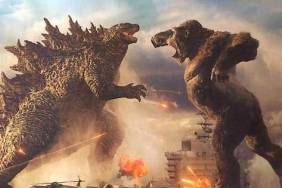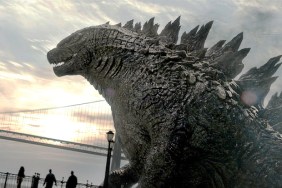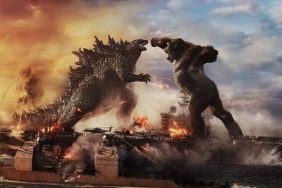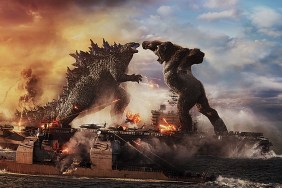さようならゴジラ。あなたは良い友人であった。
This is it, friends. The final week in my epic Summer of Godzilla in what has proven to be my longest and most ambitious entry in The Series Project to date. Maybe someday I’ll find a film series that is over 31 chapters, but it will be a tough call (Zatoichi? Django? Charlie Chan? El Santo? There aren’t many film series that achieve such a length). It’s been a long and extremely blissful trip. As I have stated in previous weeks, I didn’t expect to enjoy myself this much watching these movies. Something comes out of me when I watch Godzilla movies, that has me rooting for our famous nuclear monster as if he were competing in a high-profile boxing match as Caesar’s Palace, and I had several hundred thousand dollars on the guy to win. I find myself shouting things like “Get ‘im!” and “Twist his head off!” I become a 10-year-old, itching for monster mayhem and utter destruction. I often find myself left cold by the gun battles and destruction perpetrated by the usual rotating string of bland movie badasses from most action films, but when a 50-story nuclear amphibian is doing the damage, I’m on board, and on board with gusto. I think the Godzilla movies can do this to anyone. There is a gleeful and childish quality to all the films – even the more “serious” ones – that force you into a giddy, preadolescent stupor. You find yourself having the same enthusiasm for aliens, robots, death rays, and monsters that you had when you were in the 4th grade. My affection for Godzilla has only grown over the course of this project, and I thank you for taking the journey with me.
This week, we’ll be wrapping up the series with an examination of the final three Godzilla films from the Millennium Era, which will see the return of Mechagodzilla, another battle with Mothra, and a finale that offers up even more monsters than 1967’s Destroy All Monsters. Seriously, even Zilla from the maligned 1998 Godzilla film will become involved.
Before I begin, I will ask a question that is never really vocalized until the final Godzilla movie: Why does Godzilla want to destroy cities? It’s been an impulse of his in most of the films: He rises up from the sea after a hibernation, and heads to shore to stomp around on the people below. Watching so many Godzilla films, you begin to take this fact for granted. Godzilla will rise, and he will destroy. It’s just in his nature. But what is driving him to shore? Over the course of the series, several excuses have been given. He’s attracted to light. He’s drawn to nuclear power plants. Japan is merely his homeland, and the cities are just getting in the way of an otherwise gentle stroll. In a few of the films, he doesn’t want to destroy anything, but protect Japan from other giant monsters who would do the nation harm. In Godzilla: Final Wars, the last film in the saga (at least until the next film comes out in 2014), an explanation to Godzilla’s actual emotional motivation is given. It turns out he’s mad at humanity for making so many weapons. He is himself a symbol of the atomic bomb, having been created by a nuclear blast; He is the living manifestation of humanity’s unfortunate drive to kill itself. So when Godzilla wakes up, he’s grumpy at us. For fifty straight years, he was mad. You wanna make a weapon? Godzilla will show you weapon! In a way, Godzilla is the ultimate pacifist. He is the intellectual “war that ends all wars.” Godzilla may long for the feeling of a building crumbling pleasantly beneath his flat wrathful foot, but what he really wants is peace. The destructive monster that aches for peace. I like that.
But enough of my rambling. Let’s get to the movies. When we last left the series, we had just seen 2001’s Godzilla, Mothra, and King Ghidorah: Giant Monsters All-Out Attack, which was, as far as I could tell, a non-canonical aside in the Millennium Era., and featured a new design for the G Man. When we pick up again, we’ll be back to the Millennium continuity with…
Godzilla Against Mechagodzilla


Release Date: 14th December 2002
New Monster: Mechagodzilla a.k.a. Kiryu
Description: Badass mother****er
Origin: Half-machine cyborg made from the bones of the original Godzilla.
Destruction: Kiryu is only damaged.
Actor(s): Tsutomu Kitagawa (Godzilla), Hirofumi Ishigaki (Mechagodzilla)
I was warned by a helpful commenter last week that none of the films in the Millennium Era take place within the same continuity. This certainly was the case with GMK, the film immediately prior to this one, which was more of a stop-gap re-introduction to Godzilla than it was a reboot or proper chapter. I think, however, that the other five films in the Millennium era are indeed in continuity, even though they rarely make reference to one another. Godzilla Against Mechagodzilla, easily the best film in the Millennium Era is the pivot point for the Millennium films, as it gives us events that will be directly referenced to in other films. It establishes that the 1954 original existed, but so too did Godzilla 2000. This is the film that begins to fold up the series into something relatively cogent, and gives us one of the better monster fights in the entire series.

So in this film, Mechagodzilla is referred to as Kiryu, and is a special Earth-built superweapon designed to – what else? – destroy Godzilla once and for all. Kiryu is being built by a special elite team of engineers, and is to be piloted by a wounded young soldier named Akane (Yumiko Shaku). I’ve marked on it before, but many of the Godzilla films feature plucky, strong, and resolute women who have enough temerity and courage to either beat up a monster or befriend it accordingly. There are plenty of badass dudes floating around, but the heroine quotient is high. Akane is a notable character in the Godzilla series, even though she’ll only appear briefly in one other movie. Akane is being trained to remotely control Kiryu from a nearby superplane, and we learn all about its weapons in great detail. Kiryu has lightning breath, hundreds of missiles, and an Absolute Zero ray, which instantly freezes anything in its path.
Kiryu, by the way, was built from the skeleton of the original Godzilla from 1954. Evidently, the Godzilla skeleton was still on the ocean floor all this time, and was finally salvaged and served as the structure for this particular Mechagodzilla. Which is cool. It also means that when Mechagodzilla hears Godzilla’s signature roar, it begins to have sense memories, and springs to life, destroying things all on its own for a few minutes before running out of batteries.

The first 30 minutes of most Godzilla movies tend to be all about the human characters, their interpersonal dramas, their eventual struggles to be overcome, and it’s all typically pretty perfunctory. These plot machinations often only serve as filler until the monster mayhem can begin. I do, however, deeply appreciate this sense of pacing. If the filmmakers were to cut to the monsters too early on, it wouldn’t be as much fun. The slow build is appreciated. By the time the monster-on-monster action starts up, we’re finally ready for everything to start crumbling, and for creative glowing energy weapons to be fired off incessantly.
The monster fight in this film is, as I implied above, the best of any Godzilla film yet. The filmmakers have found a way to show off Godzilla’s massive scale, show off his capacity for destruction, and yet have both the giant monsters move quickly and fluidly and look like they’re actually fighting, all without too much CGI. It was a fear of mine that, as these films progressed into the ‘00s, that the special effects would get more and more obnoxiously digital. Toho knows, though, that their prize monster always has – and always will – look better as a man in a rubber suit. I suspect the Godzilla in the upcoming 2014 film will be CGI. Let’s hope it at least looks like a guy in a suit.

I can’t recommend this one enough. The next one isn’t bad either. Let’s look at…






